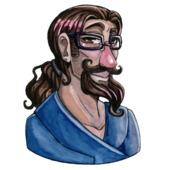Last night around 4:00 am I had this crazy idea. I figured I would post here to see if there's any plausibility behind it.
As a little background I've done a lot of programming on games, but never any art/modeling/animation.
I'm working on a solo project and need art for it. However the amount of sprites I would like in the game way too high.
Currently I'm using the Universal LPC Sprite Sheets which you can check out here
https://github.com/makrohn/Universal-LPC-spritesheet
Those allow me to change the users look depending on what items are equiped, which I quite like.
The problem is that getting someone to do custom graphics for a game with that many sprite sheets is out of the question (unless they would do it completely on rev share, lol.) I'm in college and have almost 0 budget.
Brainstorming for a solution I more or less decided the most plausible solution to this, in order to stress my (non-existent) artistic abilities as little as possible would be as follows;
- Use a program like Qubicle Constructor http://www.minddesk.com/ to create a 3d pixel model of a base character, along with pixel models of base armor and weapons. (They even have it set up to "qubify" predone 3d models, so I could even buy models somewhere and do that.)
- Take the .obj that Qubicle Constructor exports and import it into blender.
- Use something like rigify in blender to give the model a rig.
EDIT: I've found pre-rigged animations that you can simply import into blender. Ontop of that. It's very easy to qubify something in blender. So the above steps aren't really necessary.
- Create animations using that rig.
- Somewhere in here I need to make sure that I can easily add pieces of armor to this rig. Not like completely new pieces, but adding another shape of shield or something like that, and have the animations I've previously done still work nicely.
- Then do something like shown here http://www.polycount.com/forum/showpost.php?p=1615247&postcount=9 to export the animations to spritesheets.
(Here's the 3DS MAX Script http://www.geoffsamuel.com/Script_Files.php?proj=4 )
This way after I did the original animation for each armour piece, and base weapon type, I could add as many weapons and shapes as I wanted. The other benefits I see with this is being able to come up with much more advanced animations than sprite sheets usually have, and being able to create completely new animations rather easily.
If someone who had any background with animation/modeling could tell me if there are any obvious and unavoidable problems with that plan, I would appreciate it. That's all I'm looking for.
EDIT: After some research, this is actually a lot more common than I thought.
The basic steps would be:
-Find 3d model with some animations.
-Use blender to "qubify" it.
-Set blender up to look how you want it to in the spritesheet.
-Export sequence to pngs
-Create spritesheet from pngs.
And I'm sure their is some way to set parts of a blender model transparent, so I can get sprite sheets or each individual armor piece.










